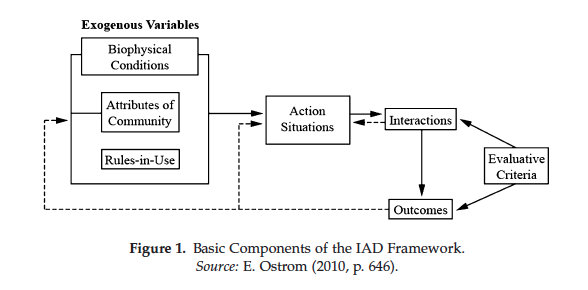Home | Overview | Schedule | Links

Introduction to Environmental Policy
Session 4
Institutional Rational Choice: Elinor Ostrom
EVR 2861
Note:
Elinor Ostrom is one of the most important voices in contemporary environmental policy - this despite her recent and unexpected demise. Thus studying her policy framework is important precisely because her work has been applied to environmental issues internationally. That said, Elinor Ostrom's 2007 article can be challenging to read. So in studying for this week's assignment I suggest watching the videos of her first in their entireity, then reading her 2010 article in the Crothers (2007) book and ending with focusing on those sections of the 2007 chapter in Sabatier's book that are targeted in the questions - in and around p. 28-32.)
Reading:
Hardin, Garrett (1968) "The Tragedy of the Commons," Science, New Series, Vol. 162, No. 3859 (Dec. 13, 1968), pp. 1243-1248.
Nijjuis, Michelle (2021) "Miracle of the Commons," Aeon. (May Edition).
Ostrom, Elinor (2007) "Institutional Rational Choice," In Paul A. Sabatier's (Ed) Theories of the Policy Process. Cambridge, MA: Westview Press, p. 21-64.
Ostrom, Elinor (2009) "Beyond Markets and States: Polycentric Governance of Complex Economic Systems," American Economic Review. Vol. 100, No. 3, p .408-444.
Ostrom, Elinor (2010) "Institutional Analysis and Development: Elements of the Framework in Historical Perspective," In Charles Crother's (Ed.) Historical Development and Theoretical Approaches in Sociology. (Volume III), New York, NY: United Nations Educational, Scientific and Cultural Organization (UNESCO).
Williams, Jeremy (2018) "Elinor Ostrom’s 8 Rules For Managing The Commons," Earthbound Report. (January 15).
Video: Ending the Tragedy of the Commons; Interview with Elinor Ostrom; Elinor Ostrom Nobel Prize in Economics Lecture
Slides: Hagedorn, Konrad "Institutional Resource Economics VI: Institutional Analysis & Development Approach"
Homework:
- What does Hardin mean by the "Tragedy of the Commons?"
- How does Ostrom propose ending the "Tragedy of the Commons?"
- Why did Elinor Ostrom enter into the research that ended in the IADA framework?
- According to Ostrom activities regarding natural resources involve "provision, production, appropriation and assignment" (Ostrom, 2007, p.29). Please expalin what she means by this.
- Ostrom also refers to the term "action" situation. What are action situations and explain the seven variables used to describe them.
- Ostrom asserts that: "information search is costly, and the information-processing capabilities of human beings are limited. Individuals, therefore, often must make choices based on incomplete knowledge of all possible alternatives and their likely outcomes" (Ostrom, 2007, p. 31). Explain what she means by this.
- Identify and discuss Ostrom's 8 Rules for managing the commons.
- What is the thesis of the article "Miracle of the Commons" and how does Ostrom's work enter into it.
- Do you subscribe to the premises of "The Tragedy of the Commons" or to that of the "Miracle of the Commons? Explain why.
- What are "institutions" in Ostrom's IADA framework and what does she mean when she talks about their "invisibility"?
